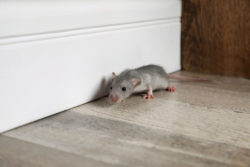Spotting rodents in your Florida home is never ideal! Rodents, including rats and mice, can cause significant damage to our homes, including destroyed insulation, chewed wires, contamination of food, and more. Controlling these creatures is first based on what type of rodent you have, as what works to control mice might not work to control rats. Every homeowner should understand their differences to place the proper prevention methods.
Mice
Mice, commonly known as house mice, are smaller than rats, ranging from four to six inches in length. They typically have light brown coloring and dark tails. These creatures prefer to live indoors and near humans, often looking towards our homes for shelter and a food source. Once inside homes, their infestation can rapidly get out of hand as they are known to breed year-round and have 14 babies per litter!
Mice prefer to eat grains and plants, but if needed, will eat leftover food and garbage. These creatures will often nest in hidden areas near these food sources, such as your kitchen. A good rule of thumb when suspecting you have mice inside is to look for their droppings, as mice will produce more droppings per day than rats (70-150). Mice droppings are smaller and usually scattered throughout the house.
Rats
There are two common rats that homeowners often come across, the Norway and Roof rats. The Norway rat is one of the largest species of rats we can come across in the Florida area. Norway rats are gray and can reach up to 16” long, measuring from the nose to the tail. These creatures will dig under buildings, along fences, and hide under debris and landscaping. This rat species is known to be difficult to control as they are very adaptive and aggressive. Norway rats can produce up to 5 litters per year, with an average of 7 babies per litter, creating a devastating infestation if they nest in a home.
Roof rats are much smaller than Norway rats, weighing less than 1 pound. These creatures have a longer tail than a head and body, with dark-colored fur and large ears. This rat species prefers to stay in higher locations, including attics, cabinets, roofs, and ceilings, where you can often find droppings which have a spindle shape with pointed ends.
Preventing Mice & Rats
The best way to prevent rodents is to place preventative measures throughout your home to ensure these creatures don’t invade.
- Clean up any spills, crumbs, and leftover food immediately, never leaving it out at night.
- Keep food, including pet food and bird seed, in sealed, airtight containers.
- Take out your garbage frequently, placing it in garbage cans with tightly sealed lids.
- Declutter your attic and basement, especially anything made from cardboard.
- Routinely trim shrubs and trees away from the sides of your home.
- Repair any holes or gaps in your foundation, garage, interior walls, and roof.
Dealing with a rodent infestation can be stressful, so if you suspect or have seen a rat or mouse at your home or property, call McCall today! Our team of Wildlife Experts will help identify the rodent and set you up with the most appropriate rodent control plan, customized to your situation.



